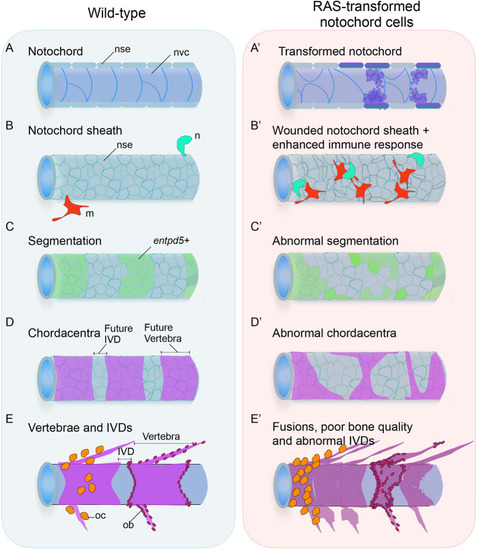
Pre-neoplastic notochord cells drive abnormal vertebral column development and interfere with bone homeostasis in zebrafish. (A) In wild-type zebrafish, the notochord is formed by a notochord sheath epithelium (nse) wrapping notochord vacuolated cells (nvc). (B) Innate immune cells, in particular neutrophils (n) and macrophages (m), are not directed to the notochord and they do not trespass the ns. (C) The segmentation of the notochord to form the future vertebrae and IVDs starts with differentiation of notochord sheath cells to express entpd5 in interspaced domains. (D) These segments will mineralise (chordacentra) and originate individual vertebrae; intersegment regions will form the IVDs. (E) Osteoblasts (ob) and osteoclasts (oc) are evenly distributed in the centrae and arches. (A′) When RAS is expressed in the notochord cells, transformed vacuolated cells collapse and a fibrous ‘scar’ tissue is formed. (B′) The notochord sheath layer is destabilised, triggering a prolonged recruitment of neutrophils and macrophages. (C′) The notochord sheath cells fail to differentiate and to express entpd5 in specific domains, showing a delay and abnormal pattern of expression. (D′) This leads to abnormal chordacentra formation, consequently leading to (E′) fusions, clefts and abnormalities in the adult vertebral column. IVDs are lost due to fusions. Osteoblasts and osteoclasts are distributed disorderly in centra and arches and in higher numbers. Moreover, pre-neoplastic cells continue to adulthood, leading to NP abnormalities and poor bone quality. Chordoma development and bone phenotype can be controlled by immunomodulation of neutrophils and macrophages.
|